I vividly recall the summer afternoons spent at my grandmother’s house, where the kitchen was filled with the sweet aroma of freshly baked goods. One of my fondest memories is of her homemade white chocolate ice cream. The rich, creamy texture and subtle sweetness were unlike any store-bought version. She would often serve it with fresh berries or a drizzle of caramel, making each scoop a delightful experience.
This cherished recipe has been passed down through generations, and I’ve made it a tradition to prepare it for family gatherings. The joy it brings to my loved ones is immeasurable. Over the years, I’ve experimented with various ingredients and techniques, refining the recipe to perfection. Whether enjoyed on a warm summer day or as a comforting treat during the colder months, white chocolate ice cream has become a staple in our household.
In this article, I will share my journey of perfecting this recipe, explore its origins, and provide tips and variations to help you create this indulgent dessert at home.
What Is White Chocolate Ice Cream?
Defining White Chocolate Ice Cream
White chocolate ice cream is a rich and creamy frozen dessert made primarily from white chocolate, cream, and sugar. Unlike traditional chocolate ice cream, which uses cocoa solids, white chocolate ice cream derives its flavor from cocoa butter, giving it a smooth and sweet taste. The absence of cocoa solids results in a pale, ivory-colored treat that melts delightfully on the tongue.
Difference Between White Chocolate and Vanilla Ice Cream
While both white chocolate and vanilla ice creams are sweet and creamy, they differ in flavor profiles. Vanilla ice cream is flavored with vanilla beans or extract, offering a subtle, aromatic sweetness. In contrast, white chocolate ice cream has a more pronounced sweetness due to the cocoa butter, with hints of milk and vanilla. The texture of white chocolate ice cream is often denser and richer, providing a more indulgent experience.
The Origins of White Chocolate Ice Cream
History and Evolution
The exact origin of white chocolate is unclear. According to the Oxford English Dictionary, the term was first used in a December 1917 issue of Scientific American magazine, describing a product made entirely of cocoa butter and sugar. In 1936, the Swiss company Nestlé launched a tablet called Nestlé Galak (known as Milkybar in the United Kingdom), which is considered one of the first commercial white chocolate products. This innovation paved the way for incorporating white chocolate into various desserts, including ice cream .
Cultural Significance
White chocolate ice cream has become a popular dessert in many cultures, often associated with luxury and indulgence. In some European countries, it is a staple in high-end patisseries, while in the United States, it has gained popularity through artisanal ice cream shops. The versatility of white chocolate allows it to be paired with various ingredients, making it a favorite among dessert enthusiasts worldwide.
Ingredients That Make It Special
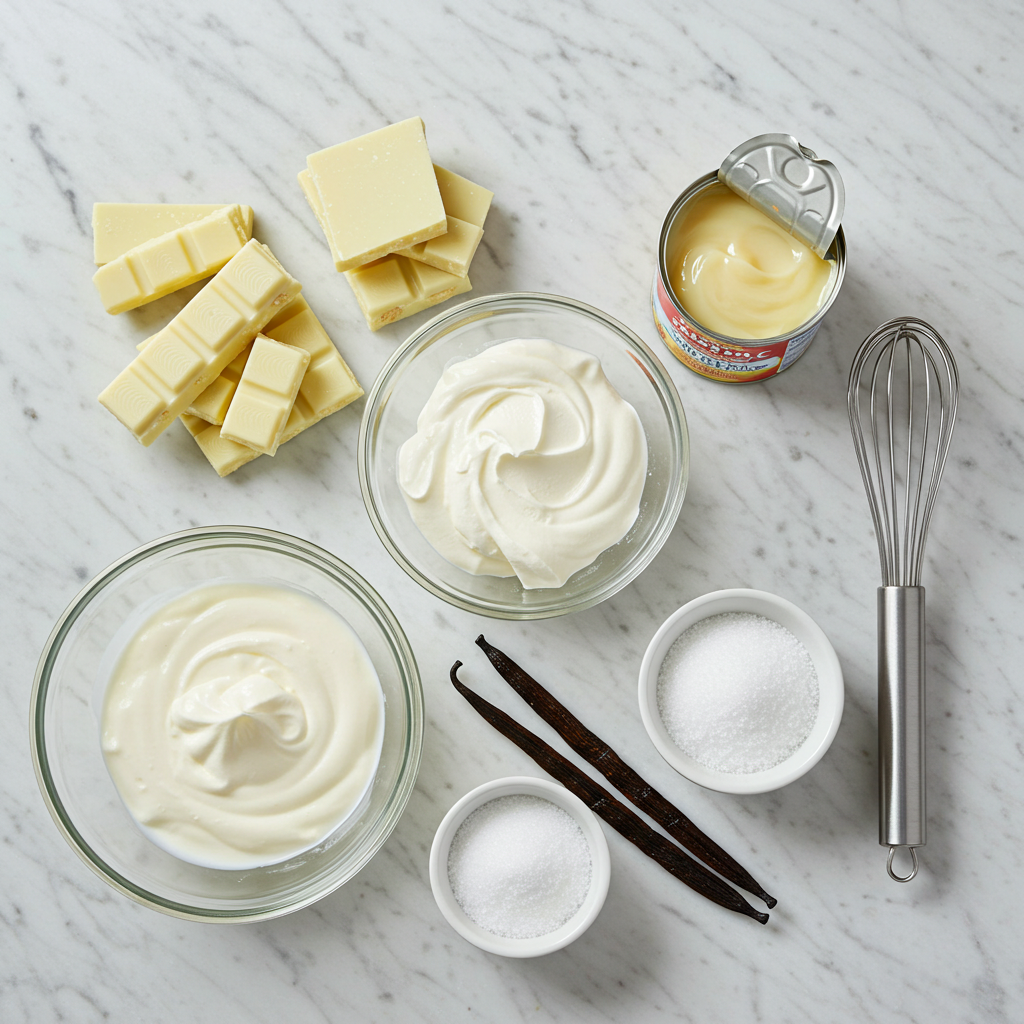
Key Components
The primary ingredients in white chocolate ice cream are white chocolate, heavy cream, and sugar. White chocolate provides the distinct flavor and creamy texture, while heavy cream contributes to the richness. Sugar balances the sweetness, ensuring a harmonious taste.
Quality Matters
Using high-quality ingredients is crucial for achieving the best flavor and texture. Opt for white chocolate with a high cocoa butter content, as this enhances the creaminess and depth of flavor. Fresh, high-fat cream will yield a smoother, more luxurious texture. Additionally, using pure vanilla extract can elevate the overall taste profile.
How to Make White Chocolate Ice Cream at Home
Step-by-Step Guide
Melt the White Chocolate: In a heatproof bowl, melt 200g of high-quality white chocolate over a pot of simmering water, stirring until smooth. Allow it to cool slightly.
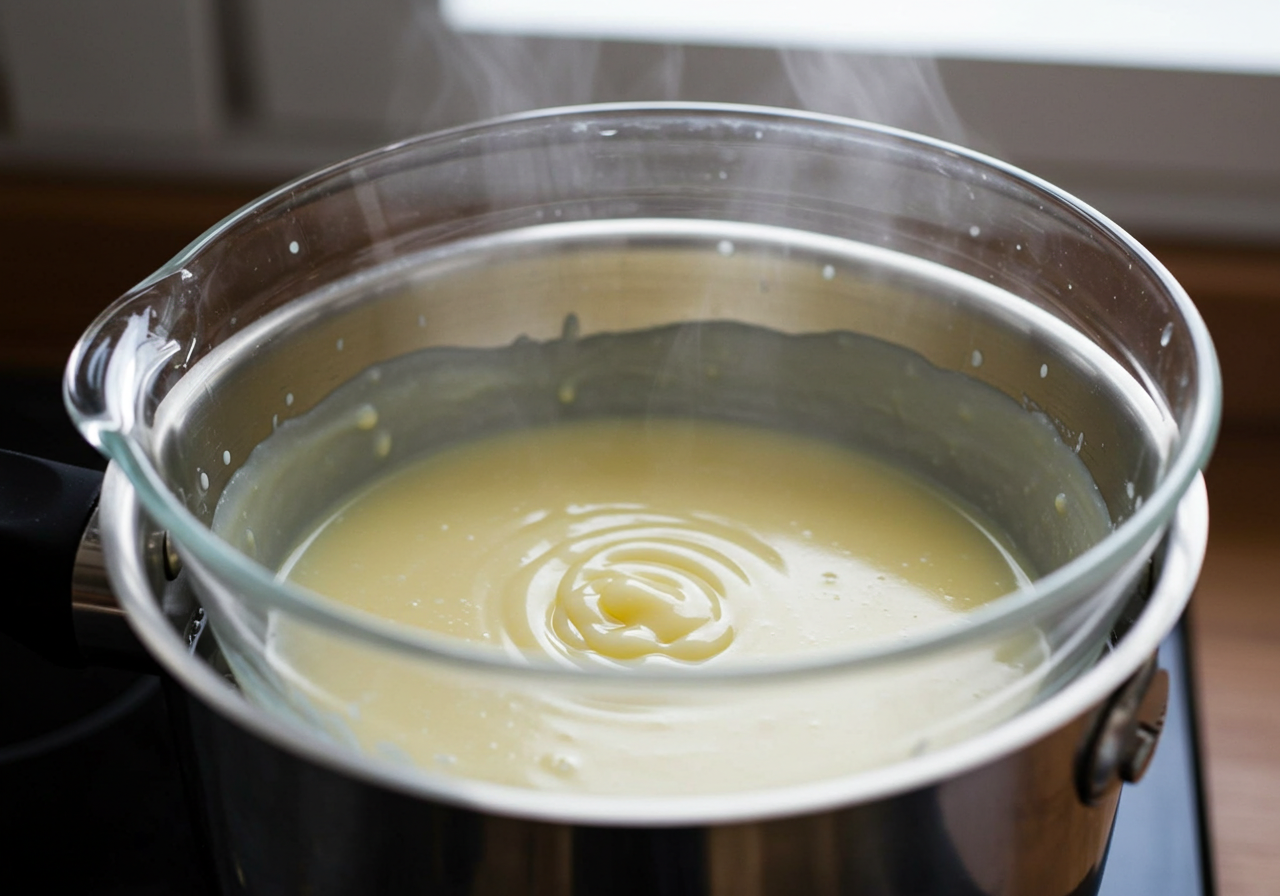
Prepare the Cream Mixture: In a separate bowl, combine 500ml of chilled heavy cream and 397g of sweetened condensed milk. Whisk until the mixture thickens and soft peaks form.
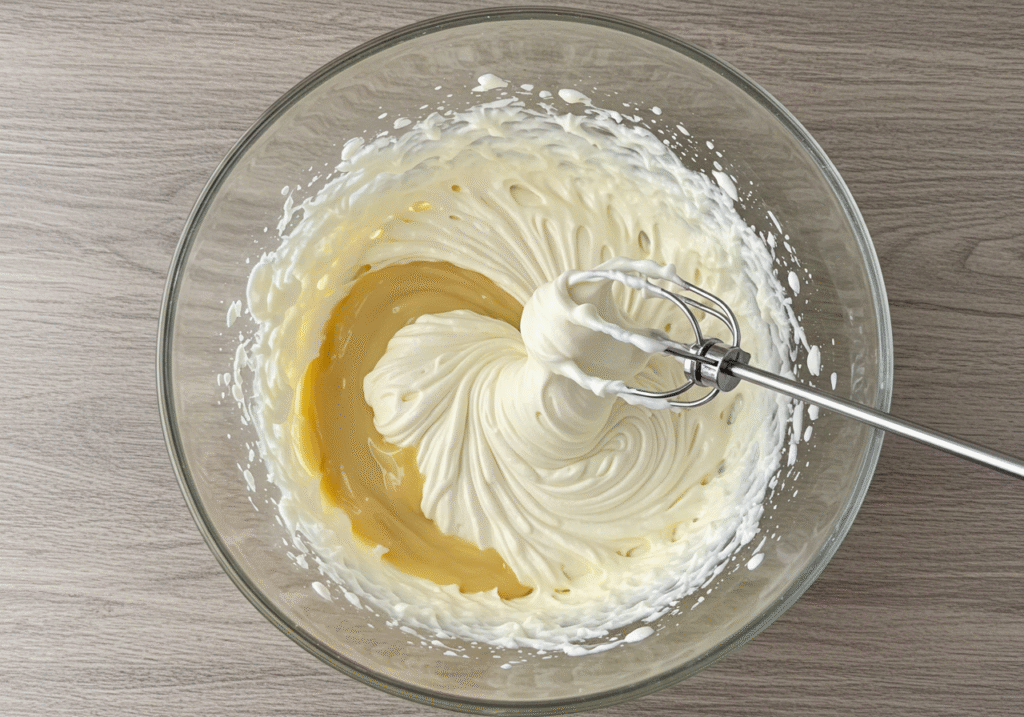
Combine Ingredients: Gently fold the melted white chocolate into the cream mixture, ensuring it is fully incorporated without deflating the cream.
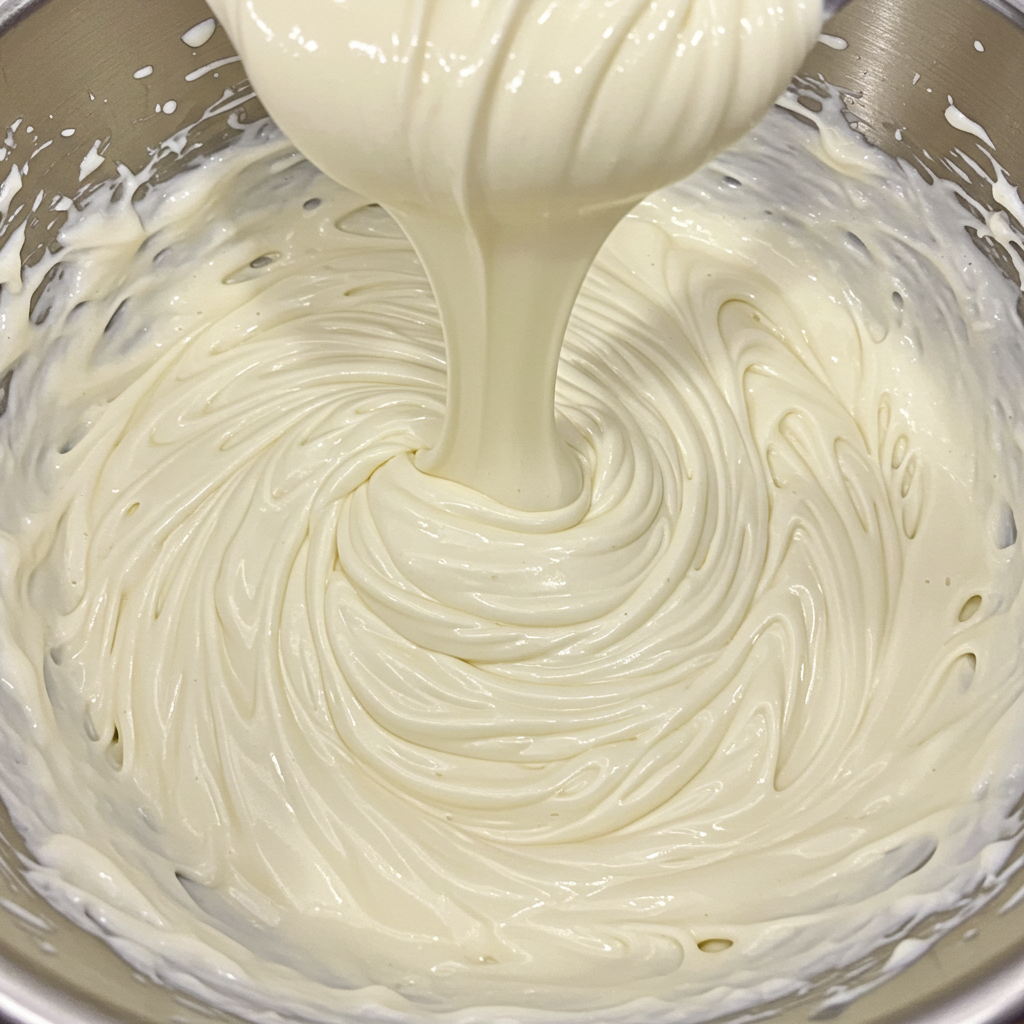
Freeze: Pour the mixture into a suitable container, cover, and freeze for at least 6 hours or until firm.
Tips for Success
- Use High-Quality Ingredients: As mentioned earlier, the quality of your ingredients significantly impacts the final product.
- Avoid Overmixing: When combining the ingredients, mix just until incorporated to maintain the airy texture.
- Proper Storage: Store the ice cream in an airtight container to prevent ice crystals from forming and to preserve its creamy texture.
No-Churn White Chocolate Ice Cream Variations
Simplifying the Process
For those without an ice cream maker, a no-churn method offers a convenient alternative. The process involves whipping heavy cream until stiff peaks form, then folding in sweetened condensed milk and melted white chocolate. This mixture is then frozen until set, resulting in a creamy, scoopable dessert without the need for churning.
Flavor Variations
Experimenting with different mix-ins can add unique flavors and textures to your ice cream. Consider incorporating:
- Fruit Swirls: Add raspberry or strawberry puree for a fruity contrast.
- Nuts: Chopped pistachios or almonds can provide a delightful crunch.
- Spices: A hint of cinnamon or nutmeg can add warmth and depth.
- Caramel: Swirling in caramel sauce can introduce a rich, buttery flavor.
Each of these additions can transform your white chocolate ice cream into a personalized treat.
Creative Mix-Ins and Flavor Pairings
Enhancing Flavor Profiles
To elevate the taste of your white chocolate ice cream, consider pairing it with complementary flavors:
- Berries: Fresh strawberries, raspberries, or blueberries add a tart contrast to the sweetness.
- Citrus: A zest of lemon or orange can provide a refreshing note.
- Herbs: Fresh mint or basil can introduce an unexpected, aromatic element.
- Spices: A dash of cinnamon or cardamom can add complexity.
Seasonal Twists
Adapting your ice cream to the seasons can make it more exciting:
- Summer: Incorporate tropical fruits like mango or pineapple for a sunny twist.
- Autumn: Add a hint of pumpkin spice or roasted chestnuts for a cozy flavor.
- Winter: Infuse with flavors like gingerbread or peppermint for a festive touch.
These variations can keep your white chocolate ice cream offerings fresh and exciting throughout the year.
Serving Suggestions and Presentation Ideas
When I prepare white chocolate ice cream, I always consider not just the flavor but also the experience of enjoying it. Presentation plays a vital role in elevating even the simplest desserts into something memorable.
Serving Styles
White chocolate ice cream can be served in a variety of ways, each enhancing its indulgent character:
- Cones: A timeless favorite, perfect for children and casual gatherings. I like to use waffle cones for added texture and a touch of nostalgia.
- Bowls: At home, I serve it in chilled bowls, often accompanied by fresh berries or crumbled meringue.
- Parfaits: For dinner parties, I assemble elegant parfaits by layering the ice cream with fruit compote, roasted nuts, and a hint of whipped cream.
- Sandwiches: Between two chewy cookies, white chocolate ice cream becomes a decadent handheld dessert.
Garnishing Tips
To further enhance the visual appeal and flavor:
- Sprinkle with white chocolate curls or shaved dark chocolate for contrast.
- Add a fresh mint sprig for color and aroma.
- Drizzle with raspberry coulis or caramel sauce for an elevated finish.
- Top with toasted pistachios or coconut flakes for texture and complexity.
These thoughtful touches transform a simple dessert into a sophisticated finale for any meal.
FAQs
Does white chocolate ice cream exist?
Yes, white chocolate ice cream most certainly exists, and it is a beloved dessert among many gourmet enthusiasts and home cooks alike. Unlike traditional chocolate ice cream that uses cocoa solids for flavor and color, white chocolate ice cream is made using cocoa butter, sugar, and milk solids ingredients that define what we know as white chocolate. This absence of cocoa solids is what gives the ice cream its pale ivory color and ultra-creamy texture.
What makes white chocolate ice cream unique is its mellow, buttery sweetness, which pairs wonderfully with berries, nuts, spices, and even caramel. It has become increasingly popular in recent years, not only in homemade recipes but also in boutique ice cream parlors and high-end restaurants. While once considered a novelty, today, it holds its own among classic flavors like vanilla and chocolate.
Consumers who are sensitive to stronger chocolate flavors or who prefer a milder dessert often gravitate toward white chocolate ice cream. It is ideal for layering flavors or enjoying on its own, making it a versatile and luxurious choice for frozen dessert lovers.
Is white chocolate ice cream the same as vanilla?
Although they may appear similar in color and texture, white chocolate ice cream and vanilla ice cream are distinctly different in both taste and composition. Vanilla ice cream is traditionally made using cream, sugar, and either vanilla extract or real vanilla beans. Its flavor profile is fragrant, floral, and slightly woody, depending on the variety of vanilla used.
White chocolate ice cream, on the other hand, is made using white chocolate which is composed of cocoa butter, sugar, and milk solids giving it a richer, creamier taste with buttery undertones. There is no vanilla bean required in authentic white chocolate ice cream, although some recipes may incorporate a touch of vanilla extract to enhance depth.
The texture also differs. White chocolate ice cream tends to be denser and silkier, largely due to the high fat content in the cocoa butter. Vanilla ice cream is usually lighter and more neutral, which is why it’s often used as a base for sundaes or dessert pairings.
While both are delicious in their own right, white chocolate ice cream offers a more indulgent and dessert-like experience one that appeals to those seeking a luxurious twist on a classic treat.
How to make white chocolate ice cream at home?
Making white chocolate ice cream at home is both rewarding and surprisingly straightforward. You do not need an ice cream machine to achieve a rich, scoopable texture just a few quality ingredients and a bit of patience.
Here is a simple no-churn recipe:
Ingredients:
300 g of high-quality white chocolate
500 ml of heavy (double) cream, chilled
397 g (1 can) of sweetened condensed milk
Method:
Melt the white chocolate over a bain-marie or in short microwave bursts. Stir until smooth, and allow it to cool slightly.
In a mixing bowl, whip the cream until soft peaks form.
Gently fold in the condensed milk, followed by the melted white chocolate.
Pour the mixture into a lidded container and freeze for at least 6 hours or overnight.
This basic method results in a creamy, luscious ice cream that holds well in the freezer for up to one month. You can customize the recipe with mix-ins like berries, crushed nuts, or caramel swirls to suit your preferences.
Just remember: allow the ice cream to sit at room temperature for 10 minutes before scooping to enjoy the perfect texture
Is white chocolate just vanilla flavored?
This is a common misconception. While white chocolate and vanilla share a similar pale appearance and sweet flavor, they are fundamentally different in both composition and taste.
White chocolate is made from cocoa butter, which is extracted from the cocoa bean, along with sugar and milk solids. Importantly, it does not contain any cocoa solids the component that gives dark or milk chocolate its deep flavor and color. The result is a smooth, buttery, and sweet confection with subtle hints of dairy and cocoa fat.
Vanilla, on the other hand, is a flavoring derived from the seed pods of the vanilla orchid. When used in ice cream, it imparts a floral and sometimes smoky aroma. While some manufacturers may add vanilla to white chocolate products for added flavor depth, white chocolate is not inherently flavored with vanilla.
Therefore, white chocolate is not merely “vanilla-flavored chocolate.” It has its own unique identity in the culinary world, appreciated for its ability to blend harmoniously with fruits, spices, and pastries. Understanding this distinction is key to appreciating the nuanced flavors in desserts like white chocolate ice cream.
Does white chocolate ice cream exist?
Yes, white chocolate ice cream most certainly exists, and it is a beloved dessert among many gourmet enthusiasts and home cooks alike. Unlike traditional chocolate ice cream that uses cocoa solids for flavor and color, white chocolate ice cream is made using cocoa butter, sugar, and milk solids ingredients that define what we know as white chocolate. This absence of cocoa solids is what gives the ice cream its pale ivory color and ultra-creamy texture.
What makes white chocolate ice cream unique is its mellow, buttery sweetness, which pairs wonderfully with berries, nuts, spices, and even caramel. It has become increasingly popular in recent years, not only in homemade recipes but also in boutique ice cream parlors and high-end restaurants. While once considered a novelty, today, it holds its own among classic flavors like vanilla and chocolate.
Consumers who are sensitive to stronger chocolate flavors or who prefer a milder dessert often gravitate toward white chocolate ice cream. It is ideal for layering flavors or enjoying on its own, making it a versatile and luxurious choice for frozen dessert lovers.
Is white chocolate ice cream the same as vanilla?
Although they may appear similar in color and texture, white chocolate ice cream and vanilla ice cream are distinctly different in both taste and composition. Vanilla ice cream is traditionally made using cream, sugar, and either vanilla extract or real vanilla beans. Its flavor profile is fragrant, floral, and slightly woody, depending on the variety of vanilla used.
White chocolate ice cream, on the other hand, is made using white chocolate which is composed of cocoa butter, sugar, and milk solids giving it a richer, creamier taste with buttery undertones. There is no vanilla bean required in authentic white chocolate ice cream, although some recipes may incorporate a touch of vanilla extract to enhance depth.
The texture also differs. White chocolate ice cream tends to be denser and silkier, largely due to the high fat content in the cocoa butter. Vanilla ice cream is usually lighter and more neutral, which is why it’s often used as a base for sundaes or dessert pairings.
While both are delicious in their own right, white chocolate ice cream offers a more indulgent and dessert-like experience one that appeals to those seeking a luxurious twist on a classic treat.
How to make white chocolate ice cream at home?
Making white chocolate ice cream at home is both rewarding and surprisingly straightforward. You do not need an ice cream machine to achieve a rich, scoopable texture just a few quality ingredients and a bit of patience.
Here is a simple no-churn recipe:
Ingredients:
- 300 g of high-quality white chocolate
- 500 ml of heavy (double) cream, chilled
- 397 g (1 can) of sweetened condensed milk
Method:
- Melt the white chocolate over a bain-marie or in short microwave bursts. Stir until smooth, and allow it to cool slightly.
- In a mixing bowl, whip the cream until soft peaks form.
- Gently fold in the condensed milk, followed by the melted white chocolate.
- Pour the mixture into a lidded container and freeze for at least 6 hours or overnight.
This basic method results in a creamy, luscious ice cream that holds well in the freezer for up to one month. You can customize the recipe with mix-ins like berries, crushed nuts, or caramel swirls to suit your preferences.
Just remember: allow the ice cream to sit at room temperature for 10 minutes before scooping to enjoy the perfect texture.
Is white chocolate just vanilla flavored?
This is a common misconception. While white chocolate and vanilla share a similar pale appearance and sweet flavor, they are fundamentally different in both composition and taste.
White chocolate is made from cocoa butter, which is extracted from the cocoa bean, along with sugar and milk solids. Importantly, it does not contain any cocoa solids the component that gives dark or milk chocolate its deep flavor and color. The result is a smooth, buttery, and sweet confection with subtle hints of dairy and cocoa fat.
Vanilla, on the other hand, is a flavoring derived from the seed pods of the vanilla orchid. When used in ice cream, it imparts a floral and sometimes smoky aroma. While some manufacturers may add vanilla to white chocolate products for added flavor depth, white chocolate is not inherently flavored with vanilla.
Therefore, white chocolate is not merely “vanilla-flavored chocolate.” It has its own unique identity in the culinary world, appreciated for its ability to blend harmoniously with fruits, spices, and pastries. Understanding this distinction is key to appreciating the nuanced flavors in desserts like white chocolate ice cream.
_____________________________________________
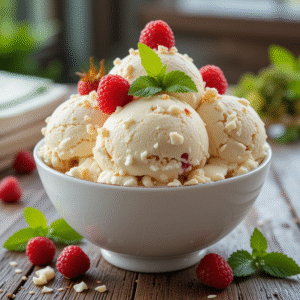
white chocolate ice cream
Ingredients
Ingredients:
- 300 g of high-quality white chocolate
- 500 ml of heavy double cream, chilled
- 397 g 1 can of sweetened condensed milk
- Sugar according to the Duke
Instructions
Step-by-Step Guide
- Melt the White Chocolate: In a heatproof bowl, melt 200g of high-quality white chocolate over a pot of simmering water, stirring until smooth. Allow it to cool slightly.
- Prepare the Cream Mixture: In a separate bowl, combine 500ml of chilled heavy cream and 397g of sweetened condensed milk. Whisk until the mixture thickens and soft peaks form.
- Combine Ingredients: Gently fold the melted white chocolate into the cream mixture, ensuring it is fully incorporated without deflating the cream.
- Freeze: Pour the mixture into a suitable container, cover, and freeze for at least 6 hours or until firm.
Notes
Nutrition Information (Per Serving)
| Nutrient | Amount |
| Calories | 315 kcal |
| Total Fat | 21 g |
| Saturated Fat | 13 g |
| Carbohydrates | 27 g |
| Sugar | 25 g |
| Protein | 4 g |
| Cholesterol | 55 mg |
| Sodium | 45 mg |
| Calcium | 90 mg |
| Potassium | 120 mg |
Conclusion:
Why White Chocolate Ice Cream Deserves a Spot in Your Freezer
Reflecting on my culinary journey with chocolate ice cream, I am continually captivated by its rich, velvety texture and nuanced sweetness. From that first spoonful shared with my kind-hearted neighbor to the countless variations I have since prepared, this dessert never fails to delight. It is far more than a simple frozen treat it is an experience in indulgence, creativity, and comfort.
Whether you are a seasoned home chef or an enthusiastic beginner, white chocolate ice cream offers an accessible yet sophisticated recipe that can be easily adapted to suit the season, occasion, or personal taste. With both churn and no-churn options available, you need not rely on professional equipment to enjoy a gourmet-quality dessert.
Beyond its luscious flavor, the versatility of white chocolate ice cream makes it a canvas for culinary expression. Whether layered in a parfait, crowned with roasted nuts, or paired with a slice of rich cake, it brings elegance and joy to any table.In closing, I encourage you to embrace the simple joy of making your own white chocolate ice cream. Not only will you savor the flavors, but you will also create memories just as I did with every batch you prepare and every bite you share.

